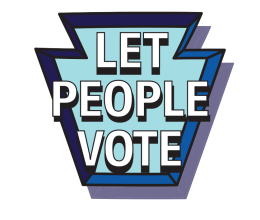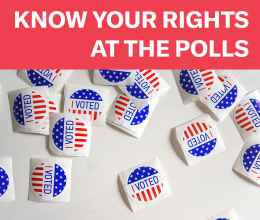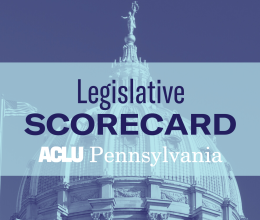
During election season, the ACLU of Pennsylvania regularly receives complaints about government officials telling people that their political signs violate local ordinances. With just a few weeks until Election Day, here's what you need to know about displaying political signs on private property.
Are political signs protected under the First Amendment?
The First Amendment to the United States Constitution protects the right to free speech, which includes the right to display signs on private property. The United States Supreme Court has recognized that a “special respect for individual liberty in the home has long been part of our culture and law,” and “residential signs have long been an important and distinct medium of expression.” In most cases, political signs, particularly those that are on private, residential property are protected by the First Amendment.
“Content-based” regulations are unconstitutional, despite local laws that might say otherwise
A common constitutional flaw in sign ordinances is that they contain “content-based” regulations, which are regulations that apply different rules to different speech, based on subject matter or viewpoint. Content-based speech regulations are unconstitutional because they allow the government to censor speech based on its content.
Common, unconstitutional, content-based regulations in sign ordinances involve setting different rules (size limits, time limits, and limits on quantity, for example) for different sign categories, such as “for sale” signs, political signs, and holiday decorations. A general rule of thumb is that if a holiday decoration or “for sale” sign is allowed, a comparable political sign also must be allowed.
If sign ordinances with content-based regulations are unconstitutional, why do so many municipalities have such ordinances?
Many municipalities have sign ordinances with unconstitutional content-based regulations simply because municipalities have not kept up with the law. Prior to the 2015 United States Supreme Court decision in Reed v. Town of Gilbert, the law was uncertain regarding what types of sign ordinance regulations are unconstitutional content-based regulations. The Supreme Court in Reed made clear that different rules (including size, time, and number limits) for different categories of signs (including “political signs”) are unconstitutional. Many municipalities have not amended their sign ordinances since Reed, so many pre-Reed, unconstitutional sign ordinances remain on the books.
Are there limits to the number or size of signs?
Most number and size limits on signs are likely invalid. As explained above, any number or size limit that applies only to certain categories of signs are unconstitutional content-based restrictions. For example, an ordinance is unconstitutional if it has a two sign limit for political campaign signs per property, but has no limit on the number of allowed holiday decorations. Similarly, an ordinance is unconstitutional if it limits political campaign signs to four square feet, but allows “for sale” signs up to eight square feet.
Number and size limits that are content-neutral (i.e., applied to all signs) also may be unconstitutional. To satisfy the First Amendment’s guarantee of free speech, content-neutral sign regulations must be narrowly tailored to serve an important government interest, and leave open sufficient alternative channels of expression. Number and size limits on signs on private, residential property are particularly suspect, because the government has limited interest in regulating speech “from the home.”
Are there any limits to how long a sign can be displayed?
Any time limits on when you may display signs are likely invalid. As explained above, time limits that apply only to certain categories of signs (like limiting political campaign signs to time periods around elections) are unconstitutional, content-based restrictions. Even if a time restriction were content-neutral and applied to all signs, it likely would be unconstitutional because a time restriction is unlikely to serve any government interest. If you want to continue displaying a “Hillary 2016” or a “Trump 2020” sign all year, on your private, residential property, the First Amendment protects your right to do so.
What about restrictions on where a sign is displayed?
Some limited restrictions on where you may post signs on your property are valid, if narrowly tailored to serve an important government interest. For example, the government could enact narrowly tailored restrictions on signs that create a safety hazard by obstructing views for motorists or pedestrians, or impose viewpoint neutral restrictions on signs in a public right of way.
Can the government require permits or fees to display a sign?
Permit and fee requirements for signs on private, residential property are generally invalid. In general, the government cannot require you to get permission before displaying messages on your own property. Such pre-approval requirements are called “prior restraints” on speech, and are presumptively unconstitutional.
Inconsistent enforcement can invalidate an otherwise legal rule on displaying signs
Even when a sign ordinance appears valid on its face, inconsistent enforcement can make enforcement against you unconstitutional. For example, enforcement of restrictions against only certain viewpoints or certain types of speech is unconstitutional. If your local government allows holiday decorations to proliferate unabated, but enforces its sign ordinance against your political message sign, then enforcement against you is likely unconstitutional. Similarly, enforcement of a sign ordinance only against signs supporting one side of a political issue is unconstitutional.
What about Homeowners’ Associations?
Homeowners’ associations are private entities that are not subject to constitutional limitations that apply to the government. Homeowners’ associations, therefore, may impose restrictions on signs that the government cannot.
If you need help regarding the government telling you to remove a sign from your private property, please contact us by filling out our online complaint form.





